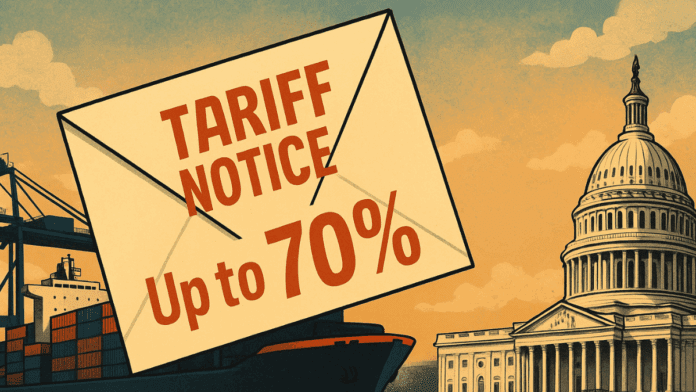The U.S. government is getting ready to send letters to its trading partners starting this Friday, July 5. These letters will tell other countries what new tariff rates they will have to pay when sending goods to the United States.
U.S. to Start Sending Tariff Letters Friday
President Donald Trump said around 10 to 12 of these letters will go out on Friday. More letters will follow over the next few days. He said that all countries should know what they will have to pay by July 9.
These new tariffs will start on August 1. That means, beginning next month, the U.S. will start collecting more money from countries that sell goods to America.
The president had earlier said he would give countries until July 9 to make trade deals with the U.S. If they didn’t, he would raise taxes on them. Now, he is making good on that promise.
Tariffs May Range From 10% to a Massive 70%
President Trump said that the new tariffs will be different for each country. Some may only have to pay 10% or 20%, but others could be hit with a much higher rate — even up to 70%.
Lee Jae Myung warns of looming economic blow if U.S. tariff deal fails by July 8
This is higher than what he originally planned back in April. At that time, he said the highest tariff would be 50%. But now, the new top rate could go even higher.
He did not name which countries will get which rates. He also did not say if certain products will get higher rates than others. What we do know is that the U.S. wants other countries to pay more unless they make a deal to avoid these high tariffs.
Trump first announced these “reciprocal” tariffs on April 2. But he paused the full plan for 90 days to let countries talk and make deals. During that time, most countries were only paying a 10% tariff.
Some Deals Done, Others Still in Talks
So far, only a few countries have made deals with the U.S. These include the United Kingdom and Vietnam. The U.S. also made a temporary peace agreement with China, which is one of its biggest trade partners.
The Vietnam deal was announced just a day ago. Under that deal, Vietnam will pay a 20% tariff on its exports to the U.S. But if goods are just passing through Vietnam from another country — especially China — they could face a 40% tariff. This is meant to stop countries from sneaking products through other nations to avoid higher U.S. taxes.
US Slaps 20% Tariff on Vietnam Imports as Trump Announces New Deal
While the Vietnam tariffs are lower than the 46% Trump had first announced, they are still much higher than the 10% many countries had been paying.
Even with this new deal, the White House has not yet shared all the details. They have not released a formal agreement or official paperwork to explain it fully.
Investors seemed happy about the Vietnam news. On Wednesday, after the deal was announced, the stock prices of U.S. companies that make products in Vietnam went up.
But many other countries like Japan, South Korea, and those in the European Union are still in talks with the U.S. They haven’t reached a deal yet. President Trump has said he thinks a deal with India might happen. But he has been very critical of Japan and has suggested they could be forced to pay tariffs of 30% or 35%, depending on what the U.S. decides.
When asked if the deadline could be moved, President Trump said there would be no delay. A U.S. Treasury official added that only the president could decide whether countries are negotiating in good faith.


